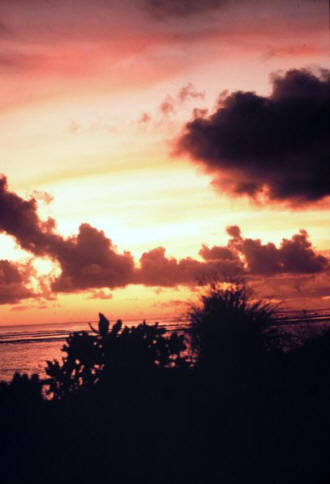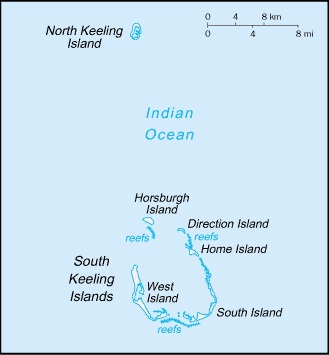| |
|
|
|
 ●
Cocos Car Rental SuperSaver ● ●
Cocos Car Rental SuperSaver ●
 |
|
Major City Listings Hotel Lodging
Accommodations in Cocos |
|
|
|
|
|
|
|
|
|
|
|
|
|
|
|
 |
|
|
Special Value SuperSaver® Rates |
|
|

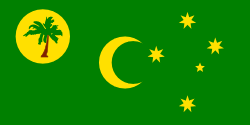
|
|
Government Palm trees on the islandsThe capital
of the Territory of Cocos (Keeling) Islands is West Island.
Some sources say that the capital is a small settlement
named Bantam which is located on West Island. Governance of
the islands is based on the Cocos (Keeling) Islands Act of
1955 and depends heavily on the laws of Australia. The
islands are administered from Canberra by the Department of
Transport and Regional Services, with a non-resident
Administrator (Neil Lucas, appointed on 30 January 2006)
appointed by the Governor-General (Neil Lucas is also the
Administrator of Christmas Island. These two Territories
together make up Australia's Indian Ocean Territories).
There also exists a unicameral Cocos (Keeling) Islands Shire
Council with seven seats. A full term lasts four years,
though elections are held every two years; approximately
half the members retire each two years. Federally, Cocos
(Keeling) Islanders form the electorate of Lingiari with
Christmas Island and outback Northern Territory.
While the islands' defence is the responsibility of
Australia, the Cocos (Keeling) Islands do have a
five-person police force.
|
The Territory of Cocos
(Keeling) Islands, also called Cocos Islands and
Keeling Islands, is a territory of Australia.
There are two atolls with 27 coral islands in
the group. The islands are located in the Indian
Ocean, about one-half of the way from Australia
to Sri Lanka, at 12°30′00″S, 96°50′00″E.
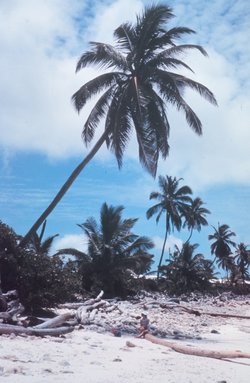 |
|
|
|
|
|
|
|
|
|
|
Cocos - (Keeling)
Islands
Find a premier Hotel & Resort at
Hilton Hotels.
or book
Sheraton Hotels and Resorts
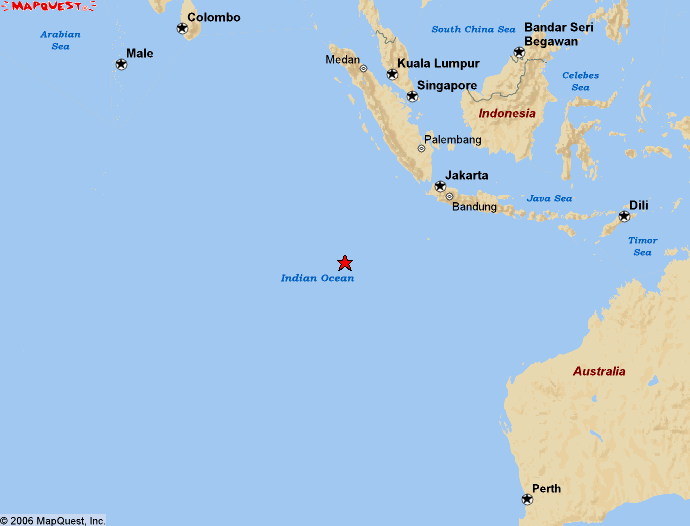 |
|
|
|
|
|
|
|
|
The Territory of Cocos (Keeling) Islands,
also called Cocos Islands and Keeling Islands,
is a territory of Australia. There are two
atolls with 27 coral islands in the group. The
islands are located in the Indian Ocean, about
one-half of the way from Australia to Sri Lanka,
at 12°30′00″S, 96°50′00″E.
History
Sunset over the islands
Unofficial Islands flag. (The official flag is
that of Australia.)Captain William Keeling
discovered the islands in 1609, but they
remained uninhabited until the 19th century,
when they became a possession of the Clunies-Ross
family. Slaves were brought to work the coconut
plantation from Indonesia, the Cape of Good Hope
and East Asia by Alexander Hare who had taken
part in Stamford Raffles' takeover of Java in
1811. A merchant seaman called Captain John
Clunies-Ross, who had also served under Raffles
in the takeover, set up a compound and Hare's
severely mistreated slaves soon escaped to work
under better conditions in the Clunies-Ross
compound.
On 1 April 1836 HMS Beagle under Captain Robert
FitzRoy arrived to take soundings establishing
the profile of the atoll. To the young
naturalist Charles Darwin who was on the ship
the results supported a theory he had developed
of how atolls formed. He studied the natural
history of the islands and collected specimens.
His assistant Syms Covington noted that "an
Englishman and HIS family, with about sixty or
seventy Mulattos from the Cape of Good Hope,
live on one of the islands. Captain Ross, the
governor, is now absent at the Cape."
The islands were brought under the British
Empire in 1857. In 1867, their administration
was placed under the Straits Settlements, which
later became known as Singapore. Queen Victoria
granted the islands in perpetuity to the Clunies-Ross
family in 1886.
On November 9, 1914, the islands became the site
of the Battle of Cocos, one of the first naval
battles of World War I. The telegraph station on
Direction Island was attacked by the German
light cruiser SMS Emden, which was destroyed
several hours later by the Australian cruiser,
HMAS Sydney.
After the Fall of Singapore in 1942 during World
War II, the islands were administered under
Ceylon (Sri Lanka), while West Island and
Direction Island were placed under Allied
military administration. On the night of 8/9 May
1942, gunners of the Ceylon Garrison Artillery
on Horsburgh Island rebelled. The Cocos Islands
Mutiny was crushed and three of the rebels were
to be the only British Commonwealth soldiers to
be executed for mutiny during the Second World
War. In 1946 the administration of the islands
was reverted back to Singapore.
On November 23, 1955 the islands were
transferred to Australian control under the
Cocos (Keeling) Islands Act 1955. In 1978,
Australia entered a form of purchase of the
islands with the Clunies-Ross family, and
subsequently manufactured an identity for locals
to whom it gave a degree of autonomy. In the
process the position of the Clunies-Ross family
has been gradually, and deliberately,
undermined.
Geography
The Cocos (Keeling) Islands consist of two flat,
low-lying coral atolls with an area of 14.2 km²,
2.6 km of coastline, a highest elevation of five
metres and thickly covered with coconut palms
and other vegetation. The climate is pleasant,
modified by the southeast trade winds for about
nine months of the year and with moderate
rainfall. Cyclones may occur in the early months
of the year.
North Keeling Island is an atoll consisting of
just one C-shaped island, a nearly closed atoll
ring with a small opening into the lagoon, about
50 m wide, on the East side. The island measures
1.1 km² in land area and is uninhabited. The
lagoon is about 0.5 km².
South Keeling Islands is an atoll consisting of
26 individual islets forming an incomplete atoll
ring, with a total land area of 13.1 km². Only
Home Island and West Island are populated.
There are no rivers or lakes on either atoll;
fresh water resources are limited to rainwater
accumulations in natural underground reservoirs.
Economy
Grown throughout the islands, coconuts are the
sole cash crop. Copra and fresh coconuts are the
major export earners. Small local gardens and
fishing contribute to the food supply, but
additional food and most other necessities must
be imported from Australia. There is a small but
growing tourist industry.
The Cocos Islands Cooperative Society Ltd.
employs construction workers, stevedores, and
lighterage worker operations. Tourism employs
others.
The islands are connected within Australia's
telecommunication system. There is one paved
airport (on the West Island) and a lagoon
anchorage.
The region's internet top-level domain is .cc.
|
|
|
Background:
|
There
are 27 coral islands in the group. Captain William
Keeling discovered the islands in 1609, but they
remained uninhabited until the 19th century. Annexed
by the UK in 1857, they were transferred to the
Australian Government in 1955. The population on the
two inhabited islands generally is split between the
ethnic Europeans on West Island and the ethnic
Malays on Home Island. |
|
Location:
|
Southeastern Asia, group of islands in the Indian
Ocean, south of Indonesia, about halfway from
Australia to Sri Lanka |
|
Geographic coordinates:
|
12 30
S, 96 50 E
|
|
Map references:
|
Southeast Asia
|
|
Area:
|
total: 14 sq km
note: includes the two main islands of West
Island and Home Island
water: 0 sq km
land: 14 sq km |
|
Area - comparative:
|
about
24 times the size of The Mall in Washington, DC
|
|
Land boundaries:
|
0 km
|
|
Coastline:
|
26 km
|
|
Maritime claims:
|
exclusive fishing zone: 200 NM
territorial sea: 12 NM |
|
Climate:
|
tropical with high humidity, moderated by the
southeast trade winds for about nine months of the
year |
|
Terrain:
|
flat,
low-lying coral atolls |
|
Elevation extremes:
|
lowest point: Indian Ocean 0 m
highest point: unnamed location 5 m |
|
Natural resources:
|
fish
|
|
Nationality:
|
noun: Cocos Islander(s)
adjective: Cocos Islander |
|
Ethnic groups:
|
Europeans, Cocos Malays |
|
Religions:
|
Sunni
Muslim 80%, other 20% (2002 est.) |
|
Languages:
|
Malay
(Cocos dialect), English |
|
Currency:
|
Australian dollar (AUD) |
|
Currency code:
|
AUD
|
|
Exchange rates:
|
Australian dollars per US dollar - 1.9354 (January
2002), 1.9320 (2001), 1.7173 (2000), 1.5497 (1999),
1.5888 (1998), 1.3439 (1997) |
|
|
|
|
|

